Exploration of students’ information behaviour and experience of assignment completion process
Chang Liu, and Xinyue Wang
Introduction. Assignments play an important role in consolidating knowledge for university students. Understanding students’ information behaviour and experience in this type of work task, i.e., students’ assignments, would be beneficial to the design of learning platforms or search systems to better support effective and efficient information behaviour.
Method. A 37-day online observation of 14 university students in China, working on one assignment through client logging, combined with questionnaires and interviews were conducted in this study.
Analysis. This study used descriptive analysis to describe students’ information behaviour and experiences during the assignment completion processes at different stages.
Results. According to the proportion of efforts devoted to seeking information and working for the assignment in four evenly distributed periods, the students could be divided into four time-allocation types, namely 'Ninjas', 'Turtles', 'Time wasters' and 'Pursuers'. Different types of students had different information behaviour and experiences during assignment completion process.
Conclusions. When applying Information Seeking Process model to analysis students’ information behaviour for the assignment completion, it is necessary to combine the time context and examine how each time allocation type of students would allocate their information seeking effort in task completion behaviour.
DOI: https://doi.org/10.47989/irisic2248
Introduction
As an important part of the learning process, university students may need to seek and collect much information to complete assignments before the deadline for submission and meet their learning goals. Learning assignments, as information intensive tasks, had long been discussed in information studies. Kuhlthau (1991) proposed information search process model to describe the information seeking process for inquiry learning, and highlighted the change of uncertainty during the process. Particularly, Kuhlthau stressed the exploration stage when students would often encounter much of unexpected uncertainty, which would also cause many negative feelings, e.g., frustration, doubt, etc. Vakkari (2001) further proposed task-based information retrieval process model to describe students’ (or researchers’) information seeking process for thesis writing. These models identified important stages of information seeking when completing a complex work task. Various empirical studies further investigated the usefulness of the Information Search Process model by different user groups or in different situations.
These studies have examined how users’ cognition, emotion and behaviour have changed in different stages, which continued to examine the usefulness of Kuhlthau’s Information Search Process (e.g., Kuhlthau, 1999; Harada, 2002; Hyldegard, 2006; Kuhlthau, Heinström and Todd, 2008). However, in practice, students may not know how to allocate their time and effort in different stages of information seeking process. As McGregor and Streitenberger (2004) found, driven by the end product, students were often unable to allow themselves time for gathering and synthesizing information as part of a process. Kuhlthau, et al. (2007) also pointed out that students could avoid missing the critical stages of learning if they allow time for reflecting and formulating while they are exploring and collecting information. Therefore, besides the guide and support for information seeking itself, it is also important for teachers and librarians to guide students in how to allocate their time and effort through this process.
There has been much research in library and information science that examined university students’ information seeking behaviour during learning or assignment completion. Most of these studies focus on the selection of information sources (Zhang and Liu, 2019; Oh, 2019; Muller, et al., 2020), interaction behaviour, e.g., query formulation (Li and Rijke 2017; Li et al., 2017) and experiences in search systems (Jiang and Liamruk, 2020; Haley and Clough, 2017). There is still a lack of analysis of the information behaviour process of university students in completing the assignments from the perspective of time.
A recent study in psychological science revealed that university students’ time management could be divided into three types: Turtles (steady workers), Ninjas (precrastinators, those who have the urge to get everything done in advance) and Time wasters (procrastinators), based on surveys and archival data set analysis (Vangsness and Young, 2020). Particularly, Turtles are the steady workers who tend to work slowly but surely (Gevers, et al., 2015). Ninjas refers to those who finish their tasks as quickly as they can (Rosenbaum, et al., 2014). Time wasters, however, are those who work a bit at the beginning, but complete most work leading up to the deadline (Silver and Sabini, 1981). This study further analysed the research-credit completion time of 8655 students in eight years. However, it is not clear how these time management types are associated with their information behaviour, and the measurements of personal experience are relatively single and subjective.
Savolainen (1995) emphasized the influence of time context on people’s information seeking behaviour in daily life in which time budget acted as an important manifestation of lifestyle in everyday life information seeking model. When the submission deadlines of assignments are approaching, students often feel time pressure, which required to be controlled, managed or relieved (Misra, et al., 2000). Therefore, proper time allocation under guidance would be necessary. Savolainen (2006) identified three dimensions of time in information behaviour, and the current study considers two of them. From the process perspective, this research explores the time allocation of university students in the process of completing their assignments as a whole, and describes students’ information behaviour during this process. From the perspective of time as scarce resources, this research also examines university students’ information search behaviour when they are approaching the deadlines.
Information related behaviour has mostly been presented as a black box in the learning cycle, but the box was seldom opened for a detailed analysis, especially in the real setting. We believe that considering different periods and different time allocation types would be beneficial for describing and understanding students’ information behaviour, and providing a new practice view of information search process in learning contexts. Students may encounter greater difficulties at certain stages or be affected by unreasonable time allocation, which makes the actual information search behaviour different from the theoretical model. Therefore, this research intends to investigate the seeking behaviour of students when completing their assignments in a reallearning context. It aims to help understand the behavioural characteristics, difficult situations and solutions of university students when they conduct information searching, and help them to complete the assignments efficiently.
In order to comprehensively observe the information search behaviour in the real situation, it is necessary to continuously observe and record it for a period of time. Therefore, combined with the research methods of online observation, questionnaire and log analysis, this study tracked the information behaviour of 14 undergraduates in five weeks, and explored the differences of students' academic information behaviour and experience in different time stages; as well as the individual differences in the completion behaviour and experience of different students. For the different time stages, we equally divided the observation period into four periods and tried to compare and align with Kulthau’s model. As for the individual differences, based on Vangsness and Young (2020), we divided students into four types, namely Turtles, Ninjas, Time Wasters and a new type, Pursuers.
Research method
Data collection
In order to observe and describe students’ academic information searching behaviour in real settings, a longitudinal observation study has been conducted. This study recruited 18 first-year students from a compulsory course in Peking University, China, and observed their information behaviour and assignment completion process from the time when they were notified about an assignment (as the beginning) till the time when this assignment was due, which lasted 37 days. This assignment involved searching for four research papers related to a topic they plan to investigate for the term project, and then wrote an annotation for each of the papers. Therefore, during this period, the student would first consider their own interests and think of several potential topics they would like to explore and then choose a topic. Then they collected related papers on his chosen topic and chose four research papers to read and then wrote an annotation for each of the four papers. This assignment was similar to the one that Kuhlthau investigated in her information search process research.
The data we collected included online observation, questionnaire and interaction logs with all the timestamps. Meanwhile, we conducted semi-interviews with the participants after they completed the assignment. It should be noted that in this study, the interviews were mainly used to understand the reasons for each participant's actions and their feelings in completing the assignments. Therefore, this study did not analyse the interview data separately, but took them as supplementary interpretations of data analysis.
Specifically, the researcher installed the screen recording software, Morae Recorder 3.3.4, on all participants’ own laptops and instructed them to use correctly. Participants were told to start Morae Recorder to record their interactions with the computer every time they planned to perform any information behaviour related to this assignment. Each time when they started Morae, the software would automatically pop up the pre-work questionnaire, collecting information about their specific goals of the current learning activity, the degree of completion of the assignments, the current mental state, etc. When the student decided to stop working on this assignment tentatively, they could stop Morae recording on their own, and then the software would automatically pop up the post-work questionnaire to inquire about the difficulties encountered in this period, and their solutions, gains, etc. A total of 14 students completed screen recordings and shared them to the researchers. Finally, 51 sessions of interaction logs of 14 students and nearly 50 hours of qualified screen recording data were obtained.
Data analysis
In order to examine how students proceed their information seeking behaviour in different stages during assignment completion process, we divided the whole assignment completion process equally by time period, as commonly done by previous researchers (Liu, Song, and Hansen,). In order to reveal more information about students’ information behaviour through the middle point, in addition to the first and last stages, we divided the search stages into four even stages, namely first stage, second stage, third stage and fourth stage (Liu et all, 2021). The 37-day time span in this study was equally divided into four stages, namely nine days per stage. On the basis of log analysis, descriptive statistics were conducted to describe the behaviour and experience of students in different time periods and different time-allocation types. By separating the time periods and time allocation type, we further explored the differences in their behaviour and experience by different time allocation types of students. Specifically, this study explored three groups of variables, as follows:
(1) Behavioural variables for assignment completion: the time spent on finding articles (understanding the requirements for articles, formulating queries in the search system, etc), selecting articles (viewing search engine results pages), reading articles and writing notes.
(2) Search interaction variables: the number of queries issued by students in the search process, the number of result pages viewed, the number of articles viewed, and the number of articles downloaded.
(3) Experience variables: time pressure, topic familiarity, anxiety (in pre-work questionnaires), satisfaction and difficulty of the assignment completion performance (in post-work questionnaires) measured by five-point Likert scale. These questionnaires were distributed every time when a participant started recording on their assignment behaviour.
Results
Behavioural characteristics at different time periods
We first examined student’ time allocations in different stages. In total, all the 18 participants spent 47 hours and 31 minutes on this assignment. Among them, the time spent in the first stage was 5 hours and 9 minutes, with a frequency of 7 times distributed in 6 days. The time spent in the second stage was 10 hours and 18 minutes, with a frequency of 14 times distributed in 8 days. The time spent in the third stage was 47 minutes, and the frequency was only 3 times distributed in 2 days. The time spent in the fourth stage was 31 hours and 15 minutes, with a frequency of 31 times distributed in 10 days. Comparing the proportion of time, frequency and days in each stage (see Figure 1), we could conclude that students spent most time in the fourth stage (66%) than in other stages, reflecting the general procrastination of university students when completing their assignments. The time investment in the second stage ranked the second (22%), followed by the first stage (11%) and the third stage (2%), which reflected that students tended to start doing their assignments within a period of time after the assignment notification, but they often put off the assignment in the third stage until the last period before the deadline. In terms of the frequency, it showed similar patterns. There were 55 times of schoolwork behaviour in total in the four stages, of which the fourth stage ranked first, accounting for 56%; followed by the second stage and the first stage, accounting for 26% and 13%; the third stage accounted only for 6%. This showed that for long-lasting and difficult tasks such as assignments, students would encounter some difficulties after the initial attempt, and would temporarily put it aside and switch to other tasks. But under the stimulus of the deadline, they reinvested a lot of time and effort to complete the assignment.
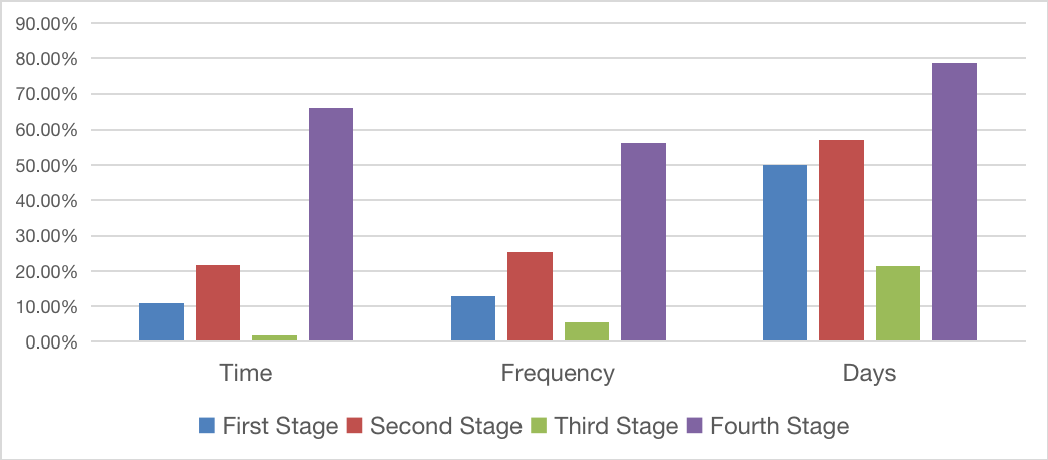
There were four types of information behaviour for assignment completion, among them, reading articles accounted for a majority of time (61%), followed by writing notes (20%) and selecting articles (14%), and finding articles accounted for the least effort (5%). Apparently, reading articles was the most time-consuming behaviour and it happened more in the first two stages and the fourth stage. With time passing by, the proportion of note writing gradually increased (see Figure 2). The behaviour of finding articles occurred more in the first three stages, and selecting articles mainly occurred in the third stage (73%). Such results reflected the process of positioning and selecting information sources at the beginning of the task and organizing information at the end of the task.

With respect to the searching interactions, all participants issued a total of 131 queries, viewed 347 search result pages, browsed 129 relevant articles and downloaded 66 articles. We counted the occurrences of search behaviour variables in each stage, and calculated the proportion of each stage with the total occurrences. As shown in Figure 3, in the first stage, various search behaviour have been tried; but the most behaviour occurred in the second stage, specifically, formulating queries accounted for 37%, viewing search result pages accounted for 38% and downloading articles accounted for 50%. There were very few search interactions in the third stage. In the fourth stage, viewing related articles (39%) occurred more frequently.
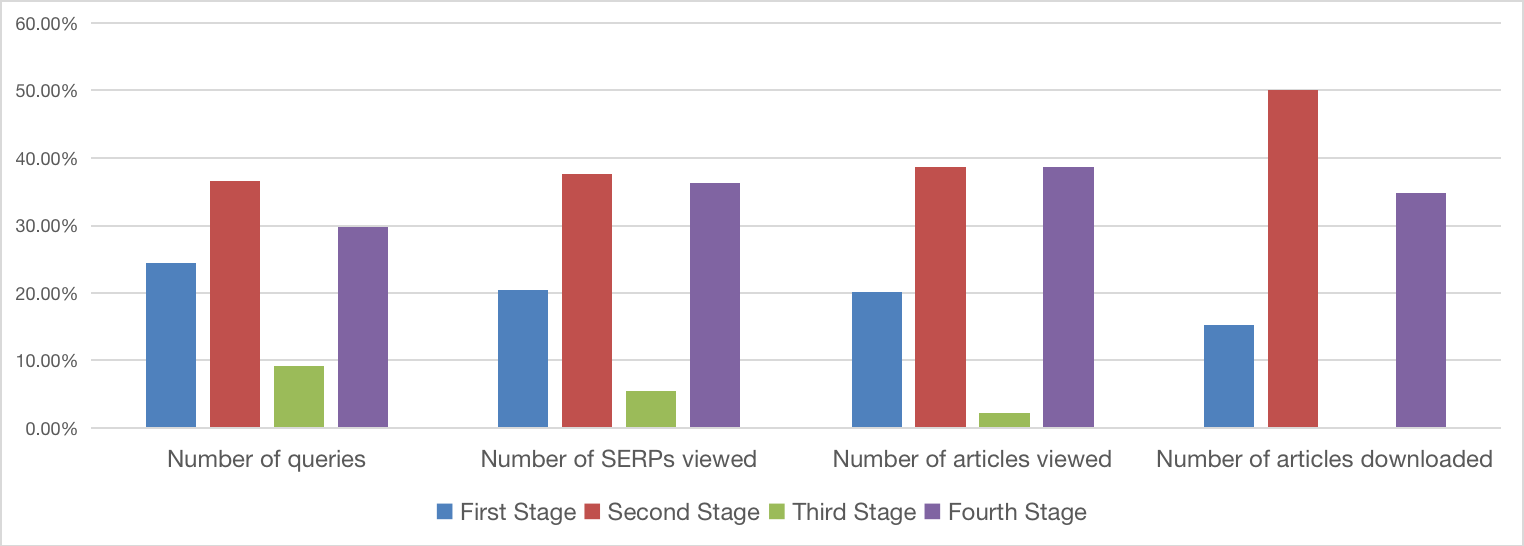
As for the experiences (see Figure 4), from the first stage to the fourth stage, time pressure, anxiety and topic familiarity showed gradual upward trends and the last stage reached to the peak. The gradual rise of time pressure and anxiety indicated that such experience was affected by how much available time they had before the submission deadline. As the deadline got closer, the perceived external time pressure and internal anxiety level increased. In the interview, a student said, 'In the last few days, I felt I couldn't finish it, so I was under great pressure.' The gradual increase in topic familiarity implied that through each information search process, students’ understanding of the topic increased. Many students mentioned that their understanding of the topic increased with the searching and reading proceeds, and one student particularly addressed it was 'an increase from 0 to more than 50%' . The degree of satisfaction of their assignment completion performance was the highest in the second stage (M=4.42) and the lowest in the third stage (M=2.50). This might be because the students in the second stage devoted more efforts, and they did not have much time pressure in the second stage since the deadline was quite far away in this stage.
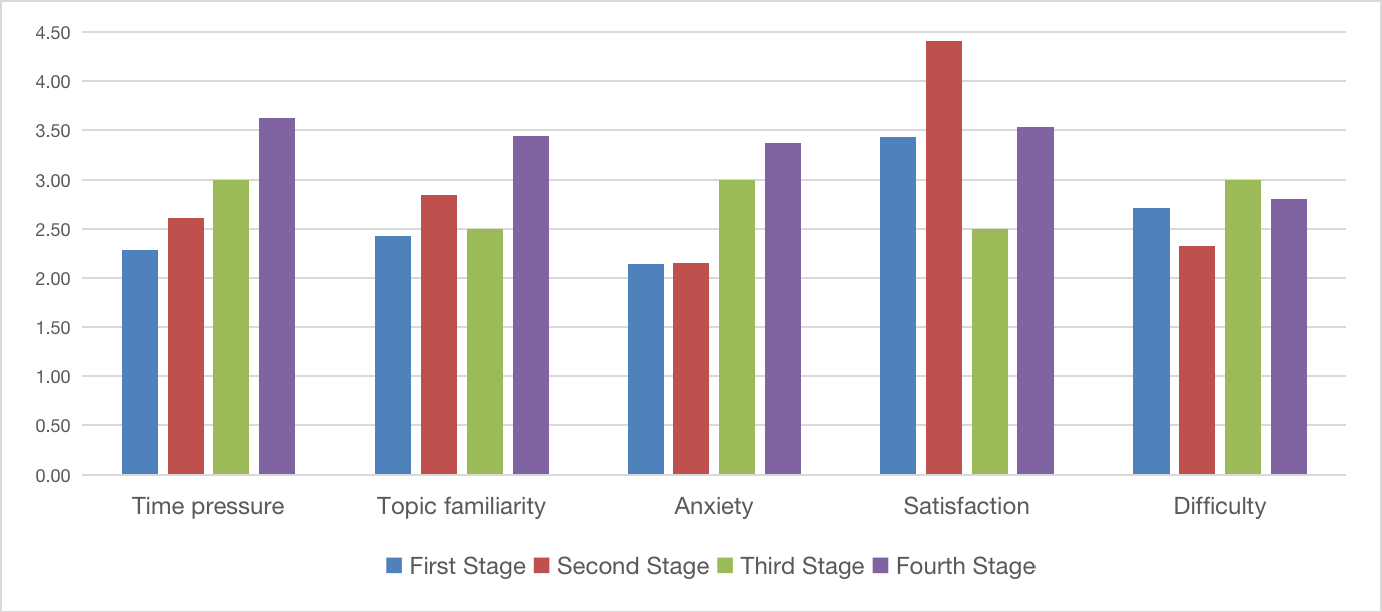
Identification of different time allocation types
In this study, all the participants completed the assignment and submitted it to the system on time. After examining all students’ time devotion efforts in the four stages (approximately 9 days per stage), we identified four types of time allocation behaviour. The first three were similar to Vangsness and Young (2020), which divided the students into 'Turtles', 'Ninjas' and 'Time wasters'. However, in the previous study, it seems that the participants all worked at each time stage by default, there are little emphasis on the type who do not react in the beginning period. Therefore, we further identified a new type with reference to this situation, called 'Pursuers'.
'Turtles' refer to the students who completing their tasks steadily in at least three stages, and 3 participants (S04, S11 and S14, shown in Figure 5) were categorized as 'Turtles' in this study. A student of 'Turtle' type described, 'I made a plan in advance... And then I did this homework at a fixed time every week'. 'Ninjas' were students who completed the assignment in the first or second stage, and they did not have any further behaviour for this assignment in the third or fourth stages. A 'Ninja' student said in the interview that, 'I finished my homework at the beginning, and time has little impact on me' . As shown in Figure 6, three participants in this study (S01, S03, and S10) belonged to this category. 'Time wasters' devoted their time and effort on this assignment in the first two stages and the fourth stage, and most of them did not work on this assignment in the third stage, but allocated exceeding 70% of time in the fourth stage. In our study, five participants (S02, S05, S08, S15, and S17) could be classified as 'Time waters' type, as shown in Figure 7. The new type of time management identified in our study was called 'Pursuers', who did not work on this assignment in the first two stages and devoted all their time and effort in the last two stages. There were three participants (S09, S12 and S18, shown in Figure 8) labelled as 'Pursuers' in this study.
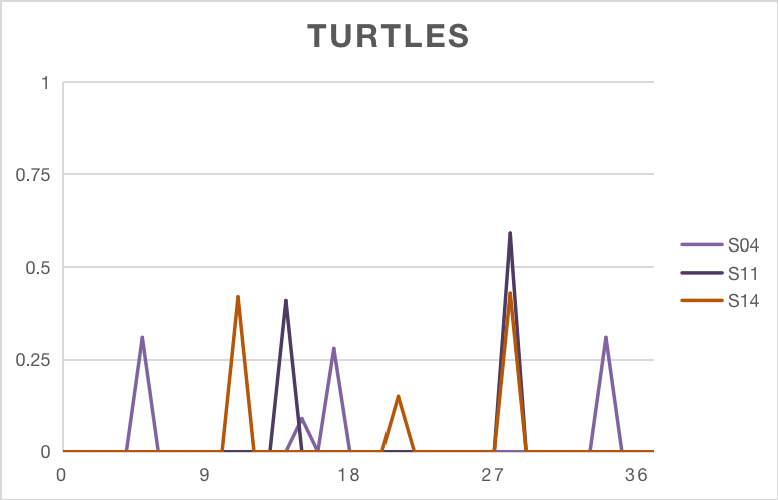
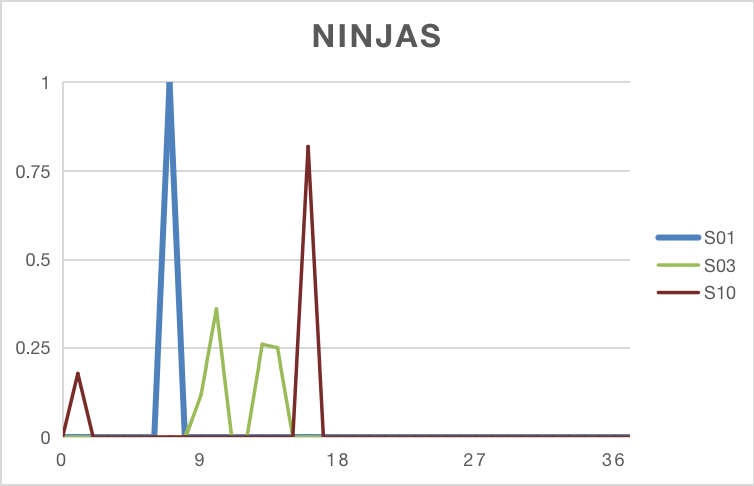
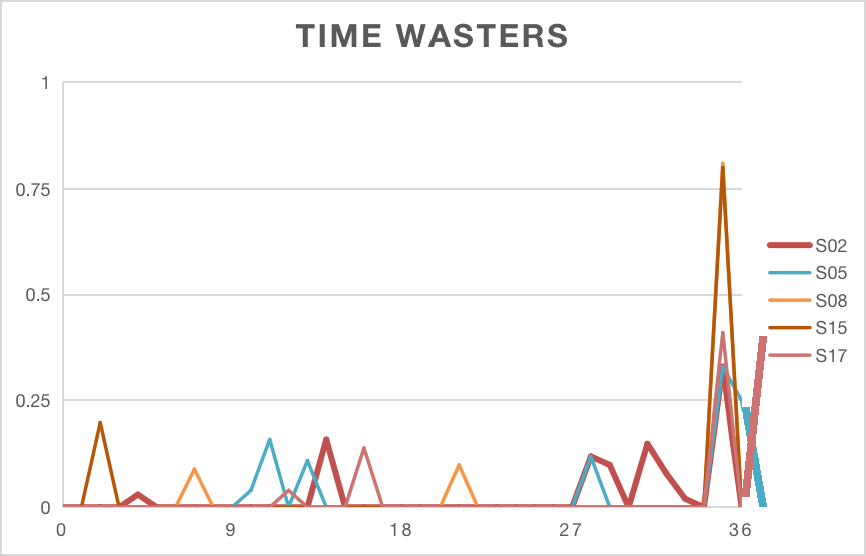
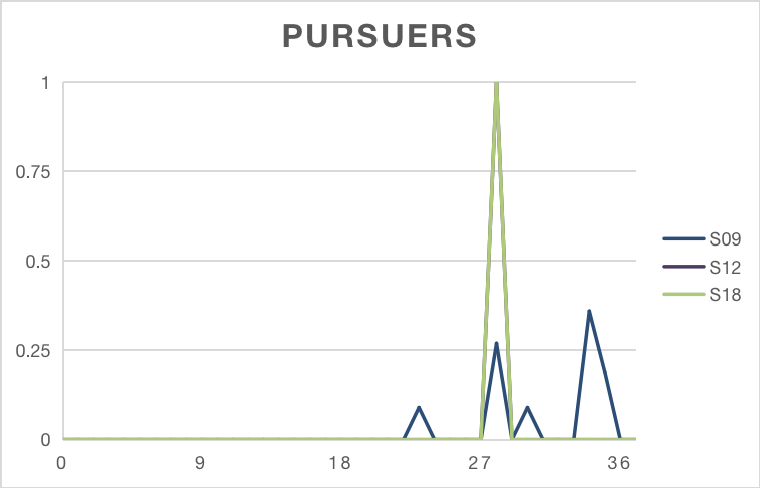
Adopted from Vangsness and Young (2020) , Figure 9 illustrated the differences among these four time-allocation types. 'Turtles' were students who work on an assignment steadily in each stage, 'Ninjas' were students who started working early and finished the assignment early, 'Time wasters' were students who spent some (but not much) time in the first two stages and spent most time in the latter two stages to complete the assignment. 'Pursuers' were students who did not work in the first two stages, and only worked for the assignment in the last two stages.
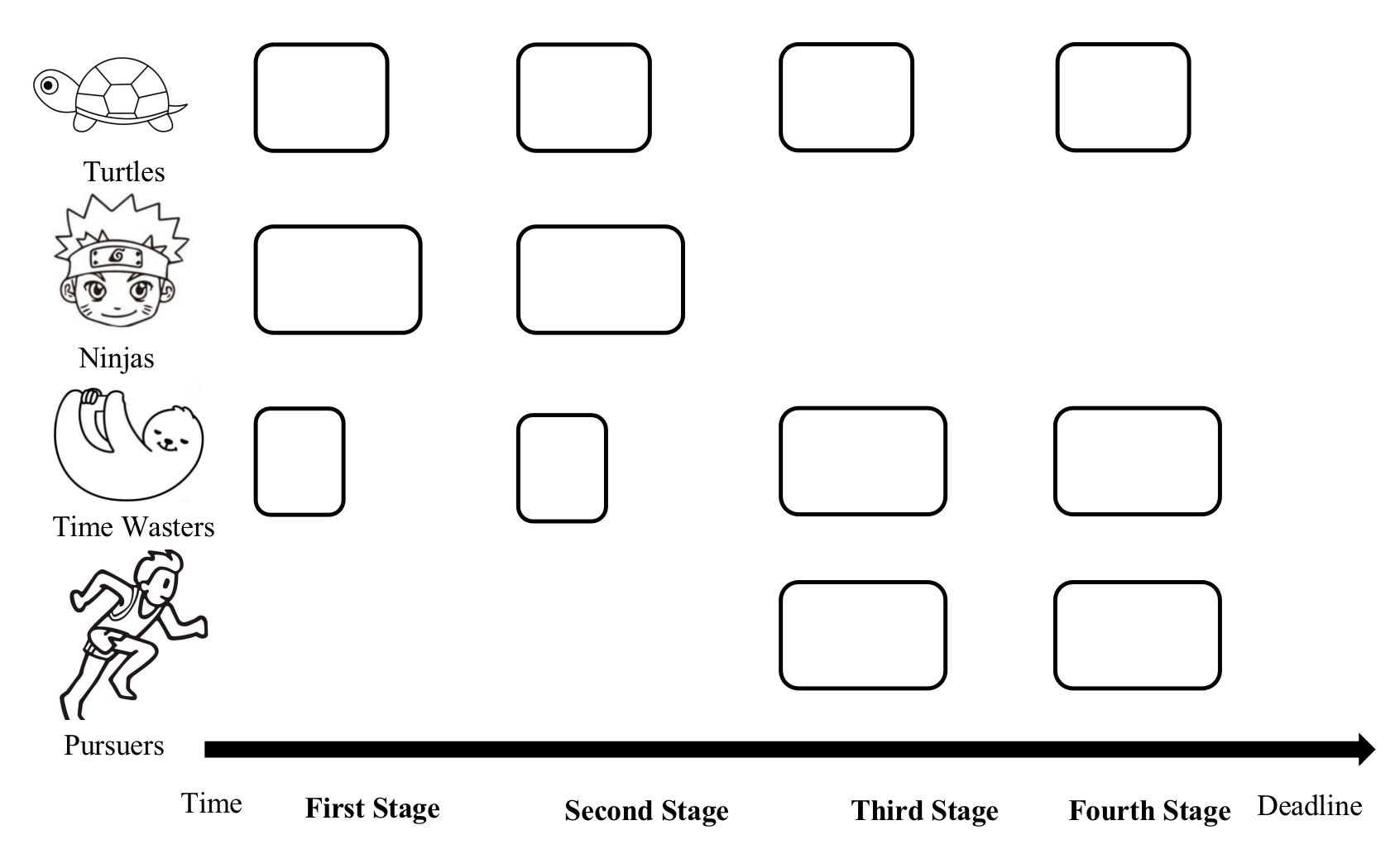
Characteristics of different time allocation types
In this section, we compared participants’ experience and search interactions among the four time-allocation types of students.
With respect to the experience measures, we used participants’ self-reported measures about time pressure, topic familiarity, anxiety, satisfaction, and experienced difficulty collected during assignment completion process. As shown in Figure 10, the anxiety level of 'Turtles' (M=3.7) and 'Pursuers' (M=4) were higher than that of 'Time wasters' (M=2. 85) and 'Ninjas' (M=1.86). The experienced difficulty level of 'Turtles' (M=3.3) was higher than that of 'Ninjas' (M=1.5). 'Pursuers' (M=4) and 'Turtles' (M=3.9) had a bit higher level of time pressure than that of 'Time Wasters' (M=3.19) and 'Ninjas' (M=2. 57). 'Turtles' (M=3.3) had a bit higher level of topic familiarity than that of 'Ninjas' (M=3), 'Time Wasters' (M=3), and 'Pursuers' (M=3). 'Ninjas' (M=4.33) and 'Pursuers' (M=4) had a bit higher level of satisfaction than that of 'Turtles' (M=3.6) and 'Time Wasters' (M=3.6).
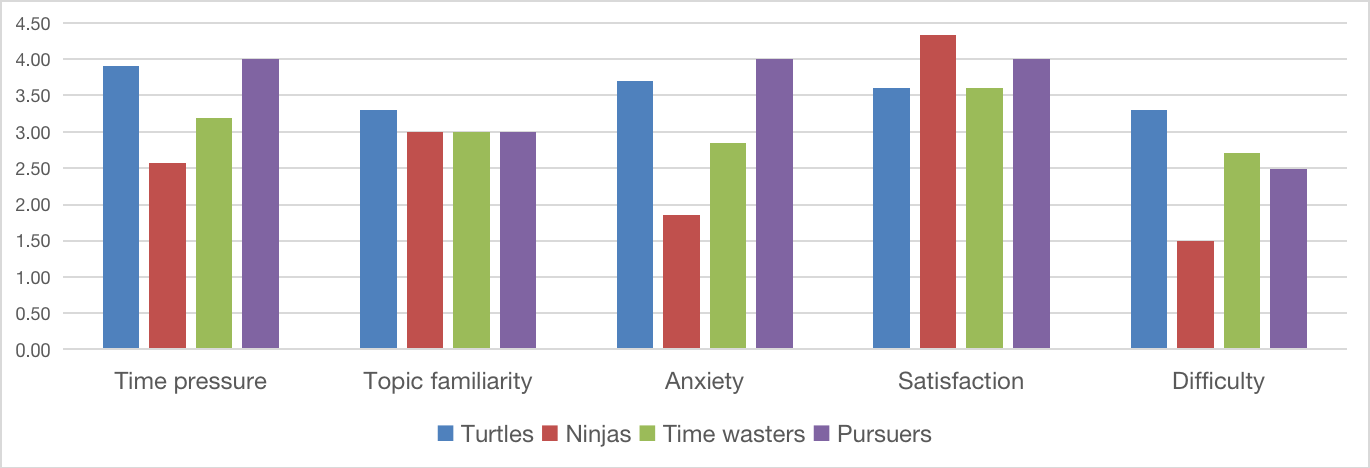
Figure 11 showed the comparison of search interactions among four time-allocation types. It was found that 'Turtles' issued most queries (M=13.33), viewed the greatest number of search result pages (M=44.33), browsed the greatest number of articles (M=13.33) and downloaded the greatest number of articles (M=7.33); while 'Pursuers' were just opposite: they issued the least number of queries (M=2.5), viewed the least number of search result pages (M=6), browsed the least number of articles (M=3) and downloaded the least number of articles (M=2.5).
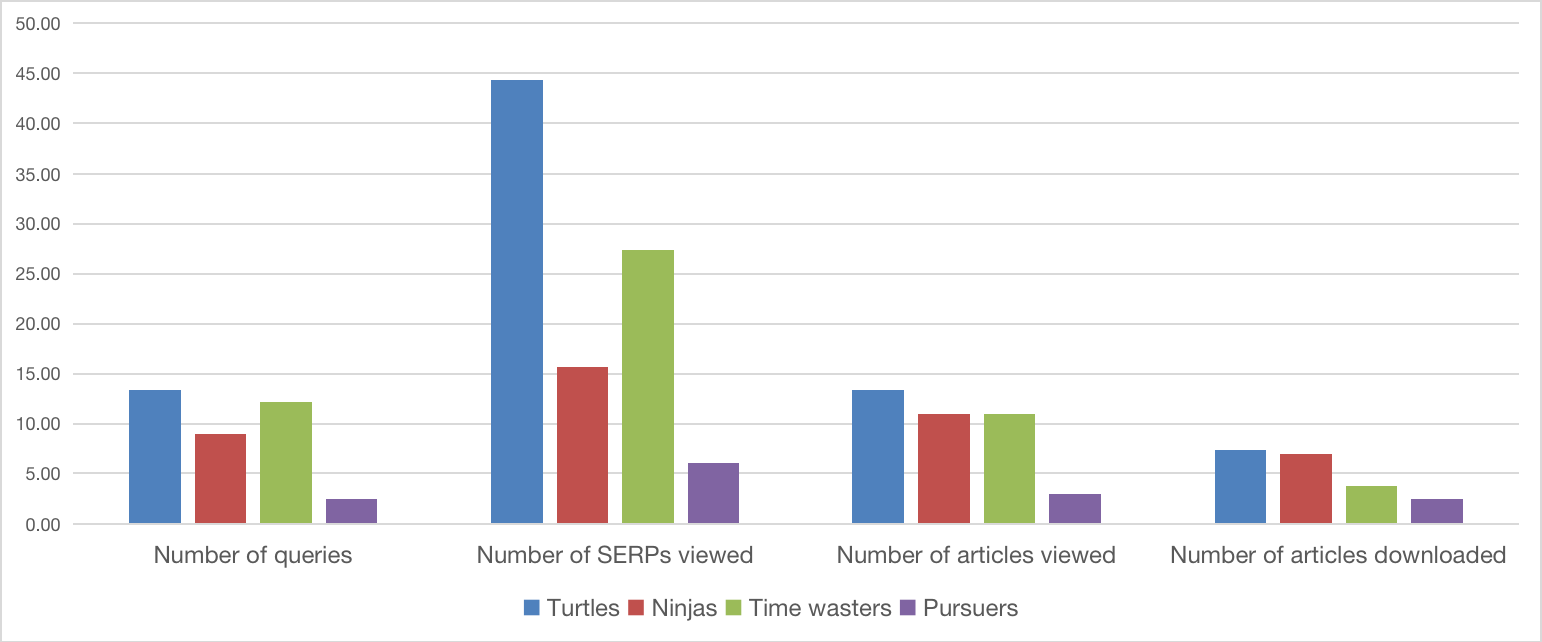
Based on the above analysis, we could summarize the overall behavioural and affective characteristics of the four types of students. 'Turtles' devoted most effort in the assignment, during which they viewed and downloaded the most articles, issued the most queries and viewed the most search result pages. 'Turtles' reported the highest topic familiarity, but they also had a higher level of experienced difficulty than others. 'Turtle' students were more likely to complete their studies (Vangsness and Young, 2020), our study found that they were also more likely to endure long-term stress. 'Ninjas' had the lowest anxiety and the highest satisfaction with their own assignment completion performance, and reported the lowest level of difficulty and the lowest time pressure. It seemed that students were more likely to have positive experience if they could finish their assignments far before the submission deadline of the assignment. Although the research of Vangsness and Young (2020) showed that 'Ninja' students were more difficult to complete their research credit requirements on time, we detected that 'Ninja' students tended to own better experiences. On a more general level, this current study not only added a new type on the basis of Vangsness and Young (2020), but also enriched the single task completion measurement method (the possibility to finish task before deadline) of the original research from the perspective of experience.'Time wasters' have devoted similar effort with 'Ninjas' in assignment completion, but their effort on the assignment was not steadily, most of the efforts were procrastinated to the periods closely to the deadline. 'Time wasters' viewed more search results pages but downloaded fewer articles than 'Ninjas', and they reported a bit higher level of time pressure and anxiety than 'Ninjas', so it seemed that they were more struggling than 'Ninjas' in choosing the relevant articles to read. Thus, they might be labelled as active procrastination type, who had strong motivation and preferences to complete the assignment efficiently under time pressure (Chu and Choi, 2005). 'Pursuers' reported the highest degree of time pressure and anxiety. Different from the proactive procrastination, the 'Pursuers' type of students devoted least effort in this assignment, and they mostly showed passive procrastination behaviour and were unable to take decisive action when the deadline was approaching.
Discussion
In information behaviour research, Information Search Process model presents us with a holistic view of information seeking in six explicit stages: initiation, selection, exploration, formulation, collection and presentation (Kuhlthau, 1991). As a useful framework for information seeking behaviour for students, Information Search Process model has been used in educational contexts in the natural settings (Kuhlthau, Heinström and Todd, 2008). These stages allowed for the embedding of tasks and important dates into each step of the information process (Reynolds, 2021). Unlike the data derived from single information-seeking episodes, Kuhlthau’s model was collected from data of students working on assignments over a period of time (Kuhlthau, 1989). Hence, a broader range of stages or more detailed behaviour and feelings could be identified in a longitudinal study like this. In this section, we further compared our preliminary results in time allocation with Kuhlthau’s Information Search Process model, and aimed to provide understandings of the information seeking behaviour by different types of students.
First of all, in the first and second stages, the dominated behaviour were finding information and reading information. The students' topic familiarity and satisfaction were gradually increasing, while the anxiety was maintained at a low level. The degree of difficulty experienced was slightly reduced. These experience indicators reflected that most students have completed the task initiation and selection of the Information Search Process model in the first and second stages of our study. During this period, they gradually accumulated knowledge of related topics, and experienced an increase of time pressure and anxiety. Next, students in the third stage mainly focused on selecting relevant resources, and experienced the lowest degree of satisfaction and the highest degree of difficulty. Such results also indicated that users often encountered more difficulties when they need to choose from a lot of relevant information. This is very similar to the characteristics of the exploration stage in the Information Search Process model. However, although the Information Search Process model considers the exploration stage to be part of the early and midterm behaviour, in fact, the exploration stage may be continued or delayed till the mid-to-late stage (the third stage). At this stage, the available time for students was insufficient, and their anxiety level and time pressure level in this stage showed a sharp rise. This may also be the reason why students had devoted least effort in the third stage.
Kuhlthau (1996) proposed the concept of zone of intervention to explain that at some point, a user may need some help to move forward for task completion. For example, exploration is a stage when uncertainty level would increase unexpectedly, so when a user moves to the exploration stage, they need help from librarians or from the information systems most. However, when or what behavioural measures indicate a user move into the exploration stage has not been fully examined. Our study is a preliminary examination towards this research goal, by identifying that for those students who may need help to move forward or pass the exploration stage, the middle point to the three quarters might be a good time for efficient intervention. In our study, we found that some students were able to complete the task far before the deadline (i.e., only used half of available time), while some other students who did not complete the task within half of the allowed time, had experienced a rising level of anxiety, time pressure and difficulty from that time to the end. These students may be more eager and more in need of help or support for the exploration stage.
Our results also suggested that time allocation and management should be considered when applying Information Search Process model. Time budget is part of the way of life, as proposed by Savolainen in Everday Life Information Seeking model, which means that people are willing to spend different time on different types of tasks. Kuhlthau (2016) has also pointed out the importance of time for Information Search Process model, as she wrote, within this task model the process of information seeking from the user’s perspective may be thought of as a sequence of choices based on four criteria: task, time, interest, and availability . The current study further verifies that there are indeed different time allocation types among students when completing assignments. For example, 'Ninjas' completed the whole process of information seeking and assignment within half of available time, while at that time 'Pursers' had just started working on it. Future research should further examine the information seeking process among different time-allocation types of students, and compare the differences in how different types of students proceed different stages of Information Search Process model.
Furthermore, it is also necessary to analyse how different types of students overcome uncertainty during assignment completion as mentioned in Information Search Process model. For example, are 'Time wasters' really wasting time? Or is it because of the difficulty in the exploration stage that it is too difficult for them to move forward on their own? What type of support do they need? In addition, would 'Pursuers' experience greater uncertainty? How would they deal with uncertainty under severe time pressure? The preliminary results from our study showed that students who completed the assignment far before the deadline ('Ninjas') had most positive experiences, while students who steadily worked on the assignment ('Turtles') had highest level of topic familiarity. The other two types of allocation showed somewhat procrastination pattern. How to help student allocate their assignment time and effort more effectively and efficiently, and overcome the difficulties and uncertainties during information seeking process are still open questions for researchers.
Limitations
This study is an exploratory examination of university students’ information behaviour for assignment completion. Since Morae Recorder 3.3.4 could be only used on laptops, we failed to document other ways of seeking information, such as verbal conversations or search behaviour using apps on cell phones. We restricted the recruitment of the participants in one single course, for just one assignment. It is difficult to conduct much statistical analysis for comparisons and the results may not be generalizable to other courses or for other types of assignment. In spite of the limitations, we believe such research-oriented type of assignments is of importance for students’ self-directed learning, and the longitudinal interaction log on the client side could provide rich data for us to better understand how students allocate their time and effort in various information behaviour at different stages. Though the participant numbers are limited, we believed that preliminary results and valuable insights could be gained. The outcomes of this current study would motivate future researchers to expand the sample size and expand to other types of assignment/courses to further verify the results in the current study.
Conclusions
This study aims to examine university students’ information behaviour for assignment completion, including seeking, examining, reading, and creating information, through an online longitudinal observation, along with interviews. Particularly, this study focused on how students allocated their time and information seeking effort in different stages. First, the results showed that students spent the longest time reading articles, followed by writing notes, selecting articles, and finding articles. With respect to the overall time allocation pattern, students spent more time on finding articles, selecting articles, and reading articles during the first part of available time, and took longer time in writing in the last period. Surprisingly, students devoted the least effort in the middle to three quarters of the available time. Then they worked under relatively high time pressure in the last stage since it was very close to the submission deadline. Secondly, this study introduced and identified four time-allocation types for assignments, namely 'Turtles', 'Ninjas', 'Time wasters' and 'Pursuers'. 'Turtles' devoted most efforts in assignments from the beginning to the end, but they still experienced high level of time pressure; 'Ninjas' completed the assignment within the first half of available time and they reported most positive experiences; 'Time wasters' started working on the assignment quite early but then put it off until the last stage, which demonstrated an active procrastination pattern; 'Pursuers' only started working on the assignment at the late stage, and showed a passive procrastination pattern with negative experiences.
This study selected two approach of time as a context proposed by Salvolainen (2006), that is, time as an indicator of the information-seeking process and time as qualifier of access to information. From the point of stages, temporal factors qualify information seeking as a process. Consequently, we discussed the information behaviour of students in different time stages when completing assignments. Information behaviour related models often mentioned the constraints by factors such as lack of time, we then analysed how students behave and affectively or cognitively react to deadlines (fourth stage). By understanding students' information seeking behaviour in a natural educational setting through online observation, this study identified students’ time allocation pattern and how it is related to different information behaviour during assignment completion process. Although it is an exploratory study, it shed lights on the future research of the combination of time context with Information Seeking Process model in different contexts.
Acknowledgements
The authors are grateful to the participants and the reviewers. This paper was supported by the Natural Social Science Foundation Project ‘Examination of the Relationship between User Interaction behaviour and Learning Effect in Learning Search’ (#18BTQ090) awarded to the first author.
About the authors
Chang Liu is an Associate Professor in the Department of Information Management, Peking University, China. She received her PhD of Library and Information Studies from Rutgers University, U.S. Her main research areas are Information Seeking and Search behaviour; Personalization in Information Retrieval; Search as Learning. She is also the Chair-Elect in Association for Information Science and Technology, Asia Pacific Chapter. ORCID: 0000-0002-9183-6385. She can be contacted at: imliuc@pku.edu.cn.
Xinyue Wang is a Ph.D. student at of Information Management, Peking University, China. Her research focuses on Information Seeking and Search behaviour. She can be contacted at: wangxinyue@stu.pku.edu.cn.
References
- Chu, Angela & Choi, Jin. (2005). Rethinking Procrastination: Positive Effects of "Active" Procrastination behaviour on Attitudes and Performance. The Journal of Social Psychology, 145(3), 345-364. https://doi.org/10.3200/SOCP.145.3.245-264
- Haley, A., & Clough, P. (2017). Affective experiences of international and home students during the information search process. New Review of Academic Librarianship, 23 (4), 396-420. https://doi.org/10.1080/13614533.2017.1308387
- Harada, V. H. (2002). Personalizing the information search process: a case study of journal writing with elementary-age students. School Library Media Annual, 5. https://alair.ala.org/bitstream/handle/11213/15759/SLMR_Vol5_PersonalizingInfoSearch.pdf (Internet Archive)
- Hyldegard, J. (2006). Collaborative information behaviour exploring Kuhlthau's information search process model in a group-based educational setting. Information Processing & Management, 42(1), 276-298. https://doi.org/10.1016/j.ipm.2004.06.013
- Jiang, S., & Liamruk, P. (2020). Effects of SERP Information on Academic Search Behaviours. 2020 - 5th International Conference on Information Technology (InCIT), 2020, 33-38. https://doi.org/10.1109/InCIT50588.2020.9310951
- Gevers, J., Mohammed, S., & Baytalskaya, N. (2015). The conceptualisation and measurement of pacing styles. Applied Psychology, 64, 499-540. https://doi.org/10.1111/apps.12016
- Kuhlthau, C. C. (1989). Information Search Process: A Summary of Research and Implications for School Library Media Programs. School Library Media Quarterly, 18, 19-25. https://www.ala.org/aasl/sites/ala.org.aasl/files/content/aaslpubsandjournals/slr/edchoice/SLMQ_InformationSearchProcess_InfoPower.pdf (Internet Archive)
- Kuhlthau. C. C. (1991). Inside the search process: information seeking from the user's perspective. Journal of the American Society for Information Science, 42, 361-371 https://doi.org/10.1002/(SICI)1097-4571(199106)42:5<361::AID-ASI6>3.0.CO;2-%23
- Kuhlthau, C. C. (1996). The Concept of a zone of intervention for identifying the role of intermediaries in the information search process. Proceedings of the 59th Annual Meeting of the American Society for Information Science, 33, 91-94.
- Kuhlthau, C. C. (1999). The role of experience in the information search process of an early career information worker: perceptions of uncertainty, complexity, construction, and sources. Journal of the American Society for Information science, 50(5), 399-412. https://doi.org/10.1002/(SICI)1097-4571(1999)50:5<399::AID-ASI3>3.0.CO;2-L
- Kuhlthau, C., Maniotes, L. & Caspari, A., (2007). Guided inquiry: learning in the 21st century. Libraries Unlimited.
- Kuhlthau, C. C. , Heinström, J., & Todd, R. J. (2008). The 'information search process' revisited: is the model still useful? Information Research, 13(4). http://informationr.net/ir/13-4/paper355.html. (Internet Archive)
- Kuhlthau, C. C. (2016). Reflections on the development of a theoretical perspective. In D. H. Sonnenwald, M. Bates, S. Chang, C. C. Kuhlthau, & J. Meadows (Eds.), Theory Development in the Information Sciences (pp. 68-86). University of Texas Press. https://doi.org/10.7560/308240-007
- Li X. & Rijke M.D. (2017). Do Topic Shift and Query Reformulation Patterns Correlate in Academic Search? Advances in Information Retrieval. ECIR 2017. Lecture Notes in Computer Science, 10193, 146-159. https://doi.org/10.1007/978-3-319-56608-5_12
- Li, X., Schijvenaars, B., & Rijke, M. D. (2017). Investigating queries and search failures in academic search. Information Processing & Management, 53(3), 666-683. https://doi.org/10.1016/j.ipm.2017.01.005
- Liu, C., Song, X., & Hansen, P. (2021). Characterising users’ task completion process in learning-related tasks: A search pace model. Journal of Information Science. https://doi.org/10.1177/01655515211060527
- McGregor, J.H., & Streitenberger, D.C. (2004). Do scribes learn? Copying and information use. In M. K. Chelton and C. Cool (Eds.). Youth information-seeking behaviour: theories, models and issues (pp. 95-118). Scarecrow Press.
- Misra, R., & McKean, M. (2000). College Students’ Academic Stress and Its Relation to Their Anxiety, Time Management, and Leisure Satisfaction. American Journal of Health Studies, 16(1), 41-51.
- Muller, S., Babes-Vroman, M., Emenike, M., & Nguyen, T. D. (2020). Exploring Novice Programmers' Homework Practices: Initial Observations of Information Seeking behaviours. Proceedings of the 51st ACM Technical Symposium on Computer Science Education, 333-339. https://doi.org/10.1145/3328778.3366885
- Oh, K. E. & Colón-Aguirre, M. (2019). A comparative study of perceptions and use of google scholar and academic library discovery systems. University & Research Libraries, 80(6), 876-891. https://doi.org/10.5860/crl.80.6.876
- Reynolds, H. (2021). The information search process and the research essay:. how one school library supports student learning by using the Information Search Process as the framework for the extended essay. IASL Annual Conference Proceedings. https://doi.org/10.29173/iasl7738
- Rosenbaum, D. A., Gong, L., & Potts, C. A. (2014). Precrastination: Hastening subgoal completion at the expense of extra physical effort. Psychological Science, 25, 1487-1496 https://doi.org/10.1177/0956797614532657
- Savolainen, R. (1995). Everyday life information seeking: approaching information seeking in the context of "'way of life"'. Library & Information Science Research, 17, 259-294. https://doi.org/10.1016/0740-8188(95)90048-9
- Savolainen, R. (2006). Time as a context of information seeking. Library & Information Science Research, 28(1), 110-127. https://doi.org/10.1016/j.lisr.2005.11.001
- Silver, M., & Sabini, J. (1981). Procrastinating. Journal for the theory of Social Behaviour, 11(2), 207-221. https://doi.org/10.1111/j.1468-5914.1981.tb00033.x
- Vakkari, P. (2001). A theory of the task-based information retrieval process: A summary and generalisation of a longitudinal study. Journal of Documentation, 57(1), 44-60. http://dx.doi.org/10.1108/EUM0000000007075
- Vangsness, L. & Young M. (2020). Turtle, Task Ninja, or Time Waster? Who Cares? Traditional Task-Completion Strategies Are Overrated. Psychological Science, 31(3), 306-315. https://doi.org/10.1177/0956797619901267
- Zhang,Y. & Liu, C. (2019). Influence of course type and assignment features on students' information seeking behaviours. Proceedings of the Association for Information Science and Technology, 56(1), 844-846. https://doi.org/10.1002/pra2.198